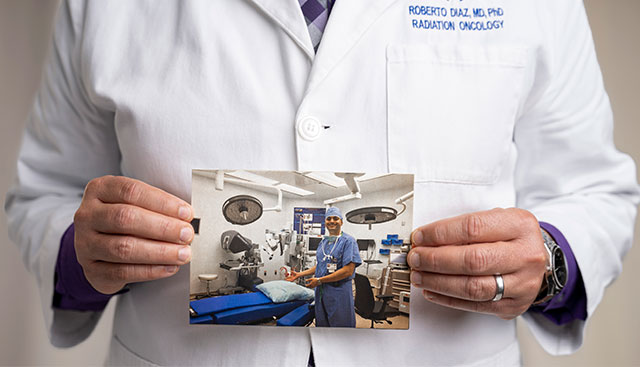
Radiation Oncologist Relates to Cancer Patients 'More Than They Know'
Dr. Roberto Diaz was the section head for breast oncology in the Radiation Oncology Department when he was diagnosed with kidney cancer.
"I was watching TV with my kids," Diaz said. "I had two on the side and one on top of me. Then suddenly, I felt a very sharp pain in my abdomen. I was thinking this is very likely to be gallstones. I had to stand up and it hit me like, ‘wow!’"
The pain persisted to the next morning. By noon it was clear something was wrong. One of his colleagues at Moffitt encouraged him to follow up with an in-house specialist.
An abdominal ultrasound was performed, and there was evidence that he likely passed a gallstone. But, the imaging also included his entire right side, where a five-centimeter tumor was found on his kidney. He was diagnosed with stage I renal cell carcinoma.
Suddenly he wasn’t the doctor anymore. He was now a cancer patient. Dr. Wade Sexton, a senior member of the Genitourinary Oncology Department at Moffitt, worked with Diaz to come up with a plan for surgery and the ensuing monitoring of the disease.
"When a physician is diagnosed with a malignancy, particularly a cancer surgeon or a cancer physician, the natural tendency is to think about all of the worst scenarios that you’ve encountered and it generates a lot of fear and anxiety and you’re suddenly living the life of your patient," said Sexton. "It really hits home when it’s somebody you’re close to, somebody you’re familiar with, or somebody with whom you’re working alongside."
The day of the surgery, the plan was for Sexton to perform a partial nephrectomy at the bottom of Diaz’s kidney. That plan quickly changed when the tumor was deeper than they initially thought. Sexton removed Diaz’s entire right kidney.
“I go into surgery with a stage I diagnosis,” said Diaz. “Then all of a sudden after the pathology report I’m at stage III. What other disease site do you have stage III cancer and the only thing we can do is surgery? There’s no chemo. There’s no radiation. No clinical trials I was eligible for. There’s nothing to do besides watch it.”
Every year Diaz went in for his scans and thought of his patients as he awaited the results. "I see patients who are in worse situations than me. I see their courage and how they fight and then keep fighting. I can relate more than they know. The anxiety that comes with waiting for scans, they call ‘scanxiety.’ I can relate to that because it’s real."
In January of 2021, Dr. Diaz marked five years of being cancer-free.
Dr. Diaz shares more about his cancer journey below:
